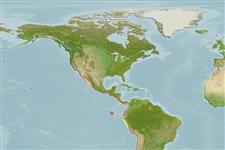>
Eupercaria/misc (Various families in series Eupercaria) >
Gerreidae (Mojarras)
Etymology: Diapterus: Greek, di = two + Greek, pteron = wing, fin (Ref. 45335).
More on author: Cuvier.
Issue
Considered as incertae sedis, in accordance with the general provisions for named-bearing types (Art. 67.2.5) of the ICZN (1999) (Ref. 75986:373-374).
Environment: milieu / climate zone / depth range / distribution range
Ecologia
marinhas demersal; intervalo de profundidade 1 - 30 m. Tropical; 32°N - 13°S, 114°W - 75°W
Eastern Pacific: Mazatlan, Mexico to Callao, Peru.
Tamanho / Peso / Idade
Maturity: Lm ? range ? - ? cm
Max length : 35.0 cm TL macho/indeterminado; (Ref. 124487); common length : 15.0 cm TL macho/indeterminado; (Ref. 55763); peso máx. publicado: 471.98 g (Ref. 124487)
Descrição suscinta
Chaves de identificação | Morfologia | Morfometria
Body diamond-shaped, compressed, and deep (depth contained 1.9 to 2.0 times in standard length); predorsal profile very compressed; mouth strongly protractile; preopercular border serrate; dorsal fin not notched to its base; second anal spine long and stout; body silver or gold with blue iridescent highlights; pelvic and anal fins yellow with dark rays (Ref. 55763).
Common in coastal waters. Juveniles inhabit lagoons of mangrove areas and tidal streams; adults are found over soft bottoms of deeper waters. May enter brackish waters (Ref. 37955). Feeds on benthic invertebrates and fishes. Its flesh is considered of good quality (Ref. 9303). Depth range assumed (RF).
Ciclo de vida ou comportamento de acasalamento
Maturities | Reprodução | Spawnings | Egg(s) | Fecundities | Larvas
González-Acosta, A.F., P. Béarez, N. Álvarez-Pliego, J. De La Cruz-Agüero and J.L. Castro-Aguirre, 2007. On the taxonomic status of Diapterus peruvianus (Cuvier, 1830) and reinstatement of Diapterus brevirostris (Sauvage, 1879) (Teleostei: Gerreidae). Cybium 31(3):369-377. (Ref. 75986)
Status na Lista Vermelha da UICN (Ref. 130435)
Ameaça para os humanos
Harmless
Uso pelos humanos
Pescarias: espécies comerciais
Ferramentas
Relatórios especiais
Baixar XML
Fontes da internet
Estimates based on models
Preferred temperature (Ref.
123201): 21 - 28.5, mean 25.9 °C (based on 54 cells).
Índice de diversidade filogenética (Ref.
82804): PD
50 = 0.5625 [Uniqueness, from 0.5 = low to 2.0 = high].
Bayesian length-weight: a=0.01318 (0.01065 - 0.01632), b=3.05 (2.99 - 3.11), in cm total length, based on LWR estimates for this species (Ref.
93245).
Nível Trófico (Ref.
69278): 3.7 ±0.2 se; based on diet studies.
Resiliência (Ref.
120179): médio(a), tempo mínimo de duplicação da população 1,4 - 4,4 anos (Preliminary K or Fecundity.).
Fishing Vulnerability (Ref.
59153): Low vulnerability (25 of 100).
Nutrients (Ref.
124155): Calcium = 173 [85, 331] mg/100g; Iron = 1.06 [0.53, 2.08] mg/100g; Protein = 18.3 [16.3, 20.2] %; Omega3 = 0.179 [0.091, 0.344] g/100g; Selenium = 46.2 [23.1, 98.7] μg/100g; VitaminA = 14 [3, 46] μg/100g; Zinc = 1.02 [0.66, 1.58] mg/100g (wet weight);
